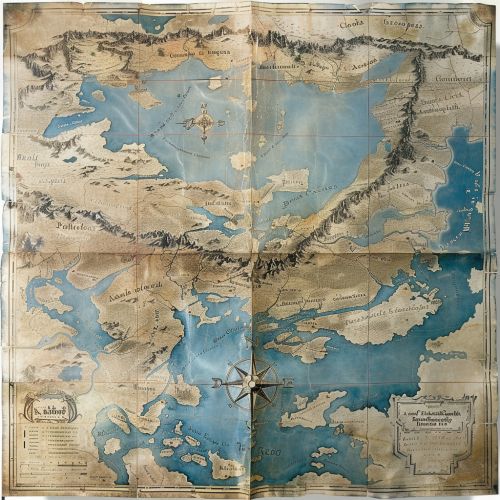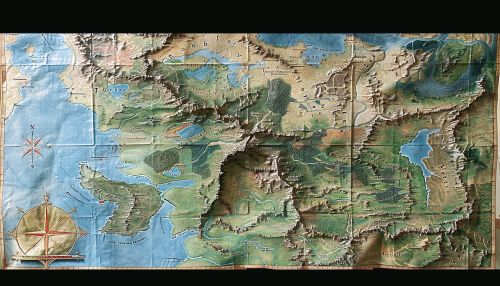Middle-earth
Overview
Middle-earth is a fictional setting created by the English author J.R.R. Tolkien. It serves as the primary setting for many of his works, including "The Hobbit," "The Lord of the Rings," and "The Silmarillion." Middle-earth is part of a larger world known as Arda, which also includes other continents such as Aman and Númenor. The term "Middle-earth" itself is derived from the Old English "Middangeard," which refers to the inhabited world of men.
Geography
Middle-earth is a diverse and expansive land, featuring a wide range of geographical features. It includes vast forests, towering mountain ranges, expansive plains, and intricate river systems. The most notable regions within Middle-earth include:
- **Eriador**: Located in the northwest, Eriador is home to the Shire, Bree, and Rivendell. It is characterized by its rolling hills, forests, and ancient ruins.
- **Rhovanion**: Also known as Wilderland, this region includes Mirkwood, the Lonely Mountain, and Lake-town. It is a land of dense forests and rugged terrain.
- **Gondor**: A powerful kingdom located in the south, Gondor is known for its impressive cities such as Minas Tirith and Osgiliath. It is bordered by the White Mountains and the Anduin River.
- **Rohan**: Situated north of Gondor, Rohan is a land of vast plains and is renowned for its horse-lords. The capital city is Edoras.
- **Mordor**: A dark and desolate region in the southeast, Mordor is the domain of the Dark Lord Sauron. It is surrounded by mountains and dominated by the volcanic Mount Doom.


History
The history of Middle-earth spans thousands of years and is divided into several ages:
- **The First Age**: This era is marked by the rise and fall of the great Elven kingdoms and the wars against Morgoth, the first Dark Lord. Key events include the creation of the Silmarils and the War of Wrath.
- **The Second Age**: This age sees the rise of Númenor, a powerful island kingdom of Men, and the forging of the Rings of Power. It ends with the Last Alliance of Elves and Men and the defeat of Sauron.
- **The Third Age**: The setting for "The Hobbit" and "The Lord of the Rings," this age is characterized by the decline of the great kingdoms and the resurgence of Sauron. It concludes with the War of the Ring and the destruction of the One Ring.
- **The Fourth Age**: This age begins with the defeat of Sauron and the crowning of Aragorn as King of Gondor. It is a time of renewal and rebuilding for Middle-earth.
Inhabitants
Middle-earth is home to a wide variety of races and creatures, each with its own unique culture and history:
- **Elves**: Immortal beings of great beauty and wisdom, the Elves are among the oldest inhabitants of Middle-earth. They are skilled in arts, crafts, and warfare.
- **Dwarves**: Stout and hardy, the Dwarves are master craftsmen and miners. They live in great underground cities such as Erebor and Khazad-dûm.
- **Men**: Mortals with a wide range of cultures and societies, Men are the most numerous race in Middle-earth. Notable groups include the Númenóreans, the Rohirrim, and the people of Gondor.
- **Hobbits**: Small, peaceful folk who live in the Shire, Hobbits are known for their love of comfort and simple pleasures.
- **Orcs**: Malevolent creatures bred by Morgoth and later Sauron, Orcs are known for their brutality and lack of compassion.
Languages
Tolkien, a philologist by profession, created several languages for the inhabitants of Middle-earth. The most notable languages include:
- **Quenya**: The ancient and formal language of the Elves, used primarily in ceremonial contexts.
- **Sindarin**: The common Elvish tongue spoken by most Elves in Middle-earth.
- **Khuzdul**: The secret language of the Dwarves, rarely spoken outside their own kind.
- **Westron**: Also known as the Common Speech, Westron is the most widely spoken language in Middle-earth, used by Men, Hobbits, and many others.
Mythology and Cosmology
Middle-earth's mythology is rich and complex, drawing heavily on Tolkien's deep knowledge of ancient myths and legends. Central to this mythology are the Valar and Maiar, powerful beings who shape the world and guide its inhabitants. The creation of the world is described in "The Silmarillion," where the god-like being Eru Ilúvatar creates the Ainur, who in turn shape the world through their music.
Key Events and Conflicts
Several major events and conflicts shape the history of Middle-earth:
- **The War of the Jewels**: A series of conflicts in the First Age centered around the Silmarils, three precious gems created by the Elf Fëanor.
- **The Downfall of Númenor**: The destruction of the island kingdom of Númenor in the Second Age, brought about by the pride and hubris of its people.
- **The War of the Last Alliance**: The final battle of the Second Age, where Elves and Men unite to defeat Sauron.
- **The War of the Ring**: The central conflict of "The Lord of the Rings," where the Free Peoples of Middle-earth unite to overthrow Sauron and destroy the One Ring.
Cultural Significance
Middle-earth has had a profound impact on modern fantasy literature and popular culture. Tolkien's meticulous world-building, rich languages, and deep mythology have inspired countless authors, filmmakers, and artists. The success of Peter Jackson's film adaptations of "The Lord of the Rings" and "The Hobbit" has further cemented Middle-earth's place in popular culture.
